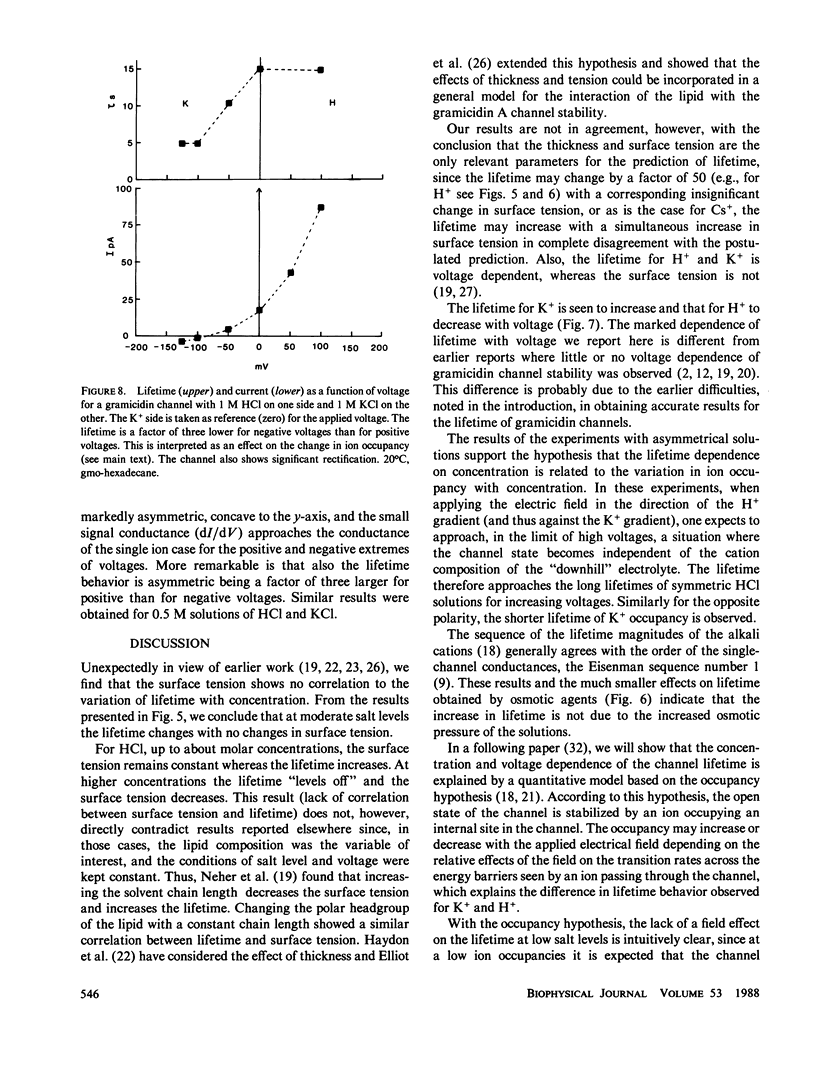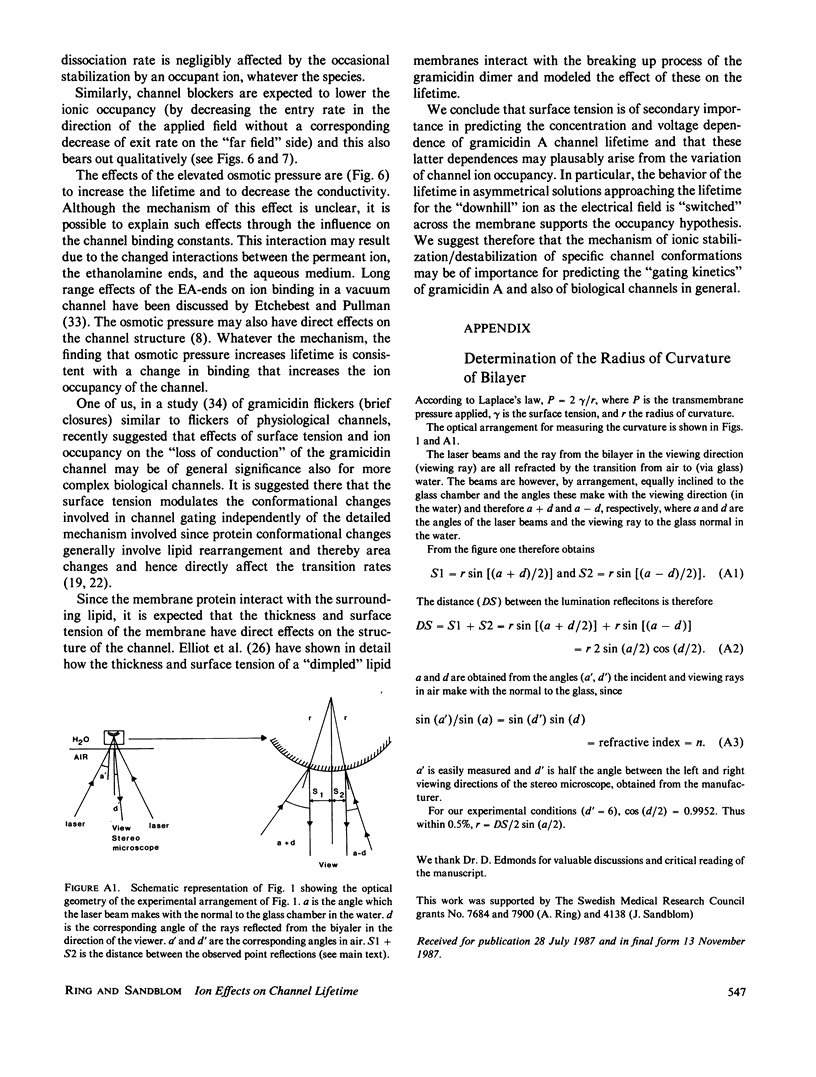Abstract
The surface tension of glycerylmonooleate-hexadecane lipid bilayer membranes and the lifetime of gramicidin A channels were measured at various concentrations of the surrounding solutions. For HCl the surface tension is essentially constant at approximately 5 mN/m up to approximately 1 M, whereas the average lifetime increases approximately 40-fold. At higher concentrations the surface tension decreases markedly. For CsCl the surface tension is constant up to about 1 M then increases with salt level. The average lifetime in this case increases about sixfold. In both cases the lifetime levels off and even decreases at higher salt levels. The increase in lifetime observed with ion activity is therefore qualitatively different from, and not explained by, the established dependence of lifetime on membrane properties (Elliot, J.R., D. Needham, J.P. Dilger, and D.A. Haydon. 1983. Biochim. Biophys. Acta. 735:95-103). We have previously proposed that ion occupancy is a determinant of channel stability, and to test this hypothesis the voltage dependence of channel lifetime was measured in asymmetrical solutions. For the case of a potassium chloride solution on one side of the membrane and a hydrogen chloride solution, on the other, the voltage dependence of the lifetime is asymmetrical. The asymmetry is such that when the electrical field is applied in the direction of the chemical gradient for each of the ions, the channel lifetime approaches, at increasing field strengths, that of a symmetrical solution of the respective ion. The voltage dependence of the surface tension, on the other hand, is negligible for the range of voltages used. These results, and the earlier findings that the order of the lifetimes for the alkali cations generally agree with the order of the permeability selectivity of the gramicidin A channel, support the hypothesis that ion occupancy is a major factor determining the lifetime of gramicidin A channels. The effects of multivalent blockers and osmotic agents were also tested. Ba2", La3+,and Mg2" decrease the lifetime and conductance markedly. Sucrose and urea increase the lifetime and decrease the conductance. The voltage dependence of the lifetime in symmetrical solutions was examined. Contrary to previous reports it was found that the lifetimes for K+, Cs', and H+ are voltage dependent. For 0.5 M HCI the lifetime decreases monotonically by .60% at 150 mV, and for 0.5 M KCI the lifetime increases by -60% at 200 mV. Below 10 mM there is no effect of voltage for H+, K+, and Cs+. These effects of blockers, osmotic agents, and voltage on the lifetime, as well as the lack of effect of voltage at low salt levels, are consistent with the occupancy hypothesis.
Full text
PDF







Selected References
These references are in PubMed. This may not be the complete list of references from this article.
- Bamberg E., Läuger P. Channel formation kinetics of gramicidin A in lipid bilayer membranes. J Membr Biol. 1973;11(2):177–194. doi: 10.1007/BF01869820. [DOI] [PubMed] [Google Scholar]
- Busath D., Szabo G. Gramicidin forms multi-state rectifying channels. Nature. 1981 Nov 26;294(5839):371–373. doi: 10.1038/294371a0. [DOI] [PubMed] [Google Scholar]
- Eisenman G., Horn R. Ionic selectivity revisited: the role of kinetic and equilibrium processes in ion permeation through channels. J Membr Biol. 1983;76(3):197–225. doi: 10.1007/BF01870364. [DOI] [PubMed] [Google Scholar]
- Elliott J. R., Needham D., Dilger J. P., Haydon D. A. The effects of bilayer thickness and tension on gramicidin single-channel lifetime. Biochim Biophys Acta. 1983 Oct 26;735(1):95–103. doi: 10.1016/0005-2736(83)90264-x. [DOI] [PubMed] [Google Scholar]
- Etchebest C., Ranganathan S., Pullman A. The gramicidin A channel: comparison of the energy profiles of Na+, K+ and Cs+. Influence of the flexibility of the ethanolamine end chain on the profiles. FEBS Lett. 1984 Aug 6;173(2):301–306. doi: 10.1016/0014-5793(84)80795-4. [DOI] [PubMed] [Google Scholar]
- Finkelstein A., Andersen O. S. The gramicidin A channel: a review of its permeability characteristics with special reference to the single-file aspect of transport. J Membr Biol. 1981 Apr 30;59(3):155–171. doi: 10.1007/BF01875422. [DOI] [PubMed] [Google Scholar]
- Fischer W., Brickmann J., Läuger P. Molecular dynamics study of ion transport in transmembrane protein channels. Biophys Chem. 1981 Apr;13(2):105–116. doi: 10.1016/0301-4622(81)80009-9. [DOI] [PubMed] [Google Scholar]
- Haydon D. A., Hendry B. M., Levinson S. R., Requena J. Anaesthesia by the n-alkanes. A comparative study of nerve impulse blockage and the properties of black lipid bilayer membranes. Biochim Biophys Acta. 1977 Oct 3;470(1):17–34. doi: 10.1016/0005-2736(77)90058-x. [DOI] [PubMed] [Google Scholar]
- Heitz F., Gavach C. Ca2+-gramicidin A interactions and blocking effects on the ionic channel. Biophys Chem. 1983 Sep;18(2):153–163. doi: 10.1016/0301-4622(83)85010-8. [DOI] [PubMed] [Google Scholar]
- Hladky S. B., Haydon D. A. Ion transfer across lipid membranes in the presence of gramicidin A. I. Studies of the unit conductance channel. Biochim Biophys Acta. 1972 Aug 9;274(2):294–312. doi: 10.1016/0005-2736(72)90178-2. [DOI] [PubMed] [Google Scholar]
- Koeppe R. E., 2nd, Hodgson K. O., Stryer L. Helical channels in crystals of gramicidin A and of a cesium--gramicidin A complex: an x-ray diffraction study. J Mol Biol. 1978 May 5;121(1):41–54. doi: 10.1016/0022-2836(78)90261-9. [DOI] [PubMed] [Google Scholar]
- Kolb H. A., Bamberg E. Influence of membrane thickness and ion concentration on the properties of the gramicidin a channel. Autocorrelation, spectral power density, relaxation and single-channel studies. Biochim Biophys Acta. 1977 Jan 4;464(1):127–141. doi: 10.1016/0005-2736(77)90376-5. [DOI] [PubMed] [Google Scholar]
- Lee W. K., Jordan P. C. Molecular dynamics simulation of cation motion in water-filled gramicidinlike pores. Biophys J. 1984 Dec;46(6):805–819. doi: 10.1016/S0006-3495(84)84079-5. [DOI] [PMC free article] [PubMed] [Google Scholar]
- Letter: Lenses and the compression of black lipid membranes by an electric field. Biophys J. 1975 Jan;15(1):77–81. doi: 10.1016/S0006-3495(75)85793-6. [DOI] [PMC free article] [PubMed] [Google Scholar]
- Mackay D. H., Berens P. H., Wilson K. R., Hagler A. T. Structure and dynamics of ion transport through gramicidin A. Biophys J. 1984 Aug;46(2):229–248. doi: 10.1016/S0006-3495(84)84016-3. [DOI] [PMC free article] [PubMed] [Google Scholar]
- Montal M., Mueller P. Formation of bimolecular membranes from lipid monolayers and a study of their electrical properties. Proc Natl Acad Sci U S A. 1972 Dec;69(12):3561–3566. doi: 10.1073/pnas.69.12.3561. [DOI] [PMC free article] [PubMed] [Google Scholar]
- Neher E., Eibl H. The influence of phospholipid polar groups on gramicidin channels. Biochim Biophys Acta. 1977 Jan 4;464(1):37–44. doi: 10.1016/0005-2736(77)90368-6. [DOI] [PubMed] [Google Scholar]
- Neher E., Sandblom J., Eisenman G. Ionic selectivity, saturation, and block in gramicidin A channels. II. Saturation behavior of single channel conductances and evidence for the existence of multiple binding sites in the channel. J Membr Biol. 1978 Apr 26;40(2):97–116. doi: 10.1007/BF01871143. [DOI] [PubMed] [Google Scholar]
- Ring A. Brief closures of gramicidin A channels in lipid bilayer membranes. Biochim Biophys Acta. 1986 Apr 25;856(3):646–653. doi: 10.1016/0005-2736(86)90160-4. [DOI] [PubMed] [Google Scholar]
- Rudnev V. S., Ermishkin L. N., Fonina L. A., Rovin YuG The dependence of the conductance and lifetime of gramicidin channels on the thickness and tension of lipid bilayers. Biochim Biophys Acta. 1981 Mar 20;642(1):196–202. doi: 10.1016/0005-2736(81)90149-8. [DOI] [PubMed] [Google Scholar]
- Urban B. W., Hladky S. B., Haydon D. A. Ion movements in gramicidin pores. An example of single-file transport. Biochim Biophys Acta. 1980 Nov 4;602(2):331–354. doi: 10.1016/0005-2736(80)90316-8. [DOI] [PubMed] [Google Scholar]
- Urban B. W., Hladky S. B. Ion transport in the simplest single file pore. Biochim Biophys Acta. 1979 Jul 5;554(2):410–429. doi: 10.1016/0005-2736(79)90381-x. [DOI] [PubMed] [Google Scholar]
- Urry D. W., Goodall M. C., Glickson J. D., Mayers D. F. The gramicidin A transmembrane channel: characteristics of head-to-head dimerized (L,D) helices. Proc Natl Acad Sci U S A. 1971 Aug;68(8):1907–1911. doi: 10.1073/pnas.68.8.1907. [DOI] [PMC free article] [PubMed] [Google Scholar]
- Urry D. W., Trapane T. L., Prasad K. U. Is the gramicidin a transmembrane channel single-stranded or double-stranded helix? A simple unequivocal determination. Science. 1983 Sep 9;221(4615):1064–1067. doi: 10.1126/science.221.4615.1064. [DOI] [PubMed] [Google Scholar]
- Urry D. W., Venkatachalam C. M., Spisni A., Läuger P., Khaled M. A. Rate theory calculation of gramicidin single-channel currents using NMR-derived rate constants. Proc Natl Acad Sci U S A. 1980 Apr;77(4):2028–2032. doi: 10.1073/pnas.77.4.2028. [DOI] [PMC free article] [PubMed] [Google Scholar]
- Warshel A., Levitt M. Theoretical studies of enzymic reactions: dielectric, electrostatic and steric stabilization of the carbonium ion in the reaction of lysozyme. J Mol Biol. 1976 May 15;103(2):227–249. doi: 10.1016/0022-2836(76)90311-9. [DOI] [PubMed] [Google Scholar]
- Weinstein S., Wallace B. A., Morrow J. S., Veatch W. R. Conformation of the gramicidin A transmembrane channel: A 13C nuclear magnetic resonance study of 13C-enriched gramicidin in phosphatidylcholine vesicles. J Mol Biol. 1980 Oct 15;143(1):1–19. doi: 10.1016/0022-2836(80)90121-7. [DOI] [PubMed] [Google Scholar]


